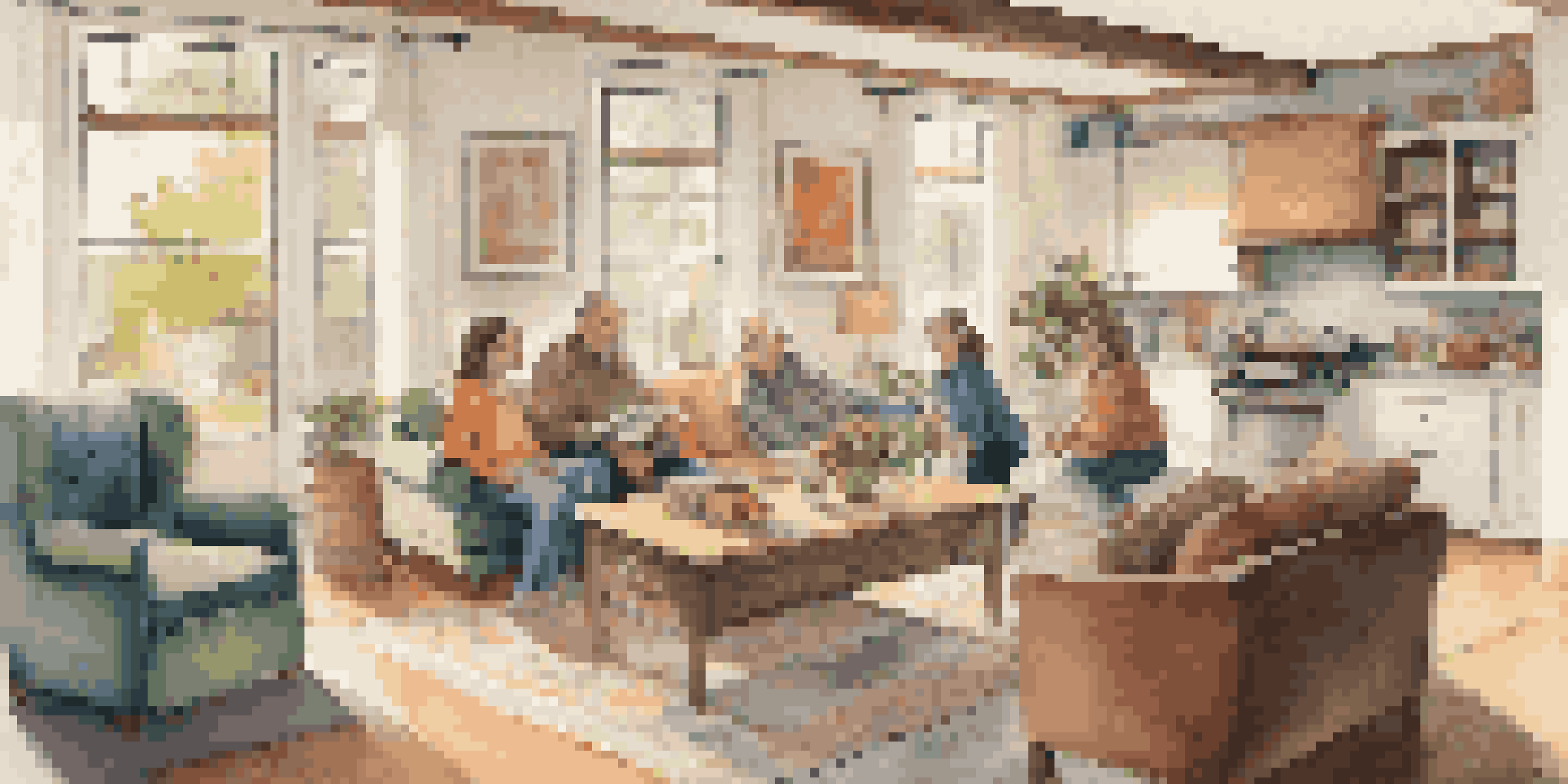Shared Living: A Sustainable Approach to Multi-Generational Housing

Understanding Shared Living and Its Benefits
Shared living is a concept that brings together people from different generations to live under one roof. This approach not only fosters a sense of community but also promotes resource sharing, which can significantly reduce living costs. Families can benefit from the wisdom and experience of older generations while younger members can offer support in technology and daily tasks, creating a balanced environment.
Alone we can do so little; together we can do so much.
By living together, residents can share household responsibilities, such as cooking, cleaning, and childcare. This collaboration can lead to stronger emotional bonds and reduce feelings of loneliness often experienced in today’s fast-paced society. It’s a refreshing shift from traditional housing models that often isolate individuals based on age.
Moreover, shared living arrangements can enhance sustainability. By pooling resources and reducing the need for multiple homes, shared living can lower energy consumption and environmental impact. This means less waste and a smaller carbon footprint, which is essential for a healthier planet.
The Rise of Multi-Generational Housing Trends
In recent years, there's been a noticeable shift towards multi-generational housing. Economic factors such as rising housing costs and the need for affordable living options have made shared living increasingly appealing. Families are realizing the advantages of living together, not just financially but also socially and emotionally.

Cultural changes are also driving this trend. Many societies are moving away from the traditional nuclear family model, embracing the idea that multiple generations can thrive together. This shift reflects a growing recognition that family structures can be diverse and that every member has something valuable to contribute.
Shared Living Reduces Costs
By pooling resources, families can significantly lower living expenses while sharing responsibilities.
Additionally, the COVID-19 pandemic has played a role in accelerating this trend. Many people have reassessed their living situations, leading to a desire for closer family ties and communal living arrangements. This has opened the door to innovative housing solutions that accommodate the needs of diverse age groups.
Designing Shared Living Spaces for All Ages
Creating a functional shared living space requires careful planning to cater to all ages. Design elements should promote accessibility, comfort, and safety, ensuring that everyone—from toddlers to seniors—can navigate the home with ease. Open floor plans, wide hallways, and ramps can make a significant difference in accommodating diverse needs.
The greatness of a community is most accurately measured by the compassionate actions of its members.
Incorporating communal areas is essential for fostering interaction among residents. Spaces like shared kitchens, gardens, and living rooms encourage socialization and collaboration, helping to build a strong sense of community. Meanwhile, private spaces are equally important, allowing individuals to retreat and have their own moments of peace.
Furthermore, integrating technology can enhance the living experience. Smart home devices can aid seniors in managing daily tasks, while younger residents can help set up systems that promote connectivity and security. This blend of design and technology creates a harmonious environment that caters to all generations.
Legal Considerations for Shared Living Arrangements
When considering shared living, it’s important to understand the legal implications involved. Zoning laws may affect the feasibility of multi-generational housing, and it’s crucial to research local regulations before making any decisions. Compliance with these laws can help avoid potential conflicts and ensure a smooth living arrangement.
Additionally, establishing clear agreements among residents is vital. This includes outlining responsibilities, financial contributions, and expectations for communal living. Having these discussions upfront can prevent misunderstandings and foster a cooperative atmosphere.
Community Bonds Enhance Well-Being
Living together fosters strong relationships and emotional support, reducing feelings of loneliness.
Finally, it's wise to consult with a legal professional experienced in housing law. They can provide guidance on creating a living arrangement that meets everyone’s needs while adhering to legal standards. This proactive approach can help ensure that shared living is a rewarding experience for all involved.
Financial Benefits of Shared Living for Families
One of the most immediate advantages of shared living is the potential for significant cost savings. Families can pool their resources to cover expenses such as rent or mortgage payments, utilities, and groceries. This collective approach can ease financial burdens and allow for a more comfortable lifestyle.
Moreover, shared living can provide an opportunity for income generation. For instance, families can rent out extra rooms or offer short-term accommodations to help offset living costs. This flexibility can create a financial cushion, making it easier for families to save or invest in other areas.
In the long run, shared living can foster a sense of financial security. With shared responsibilities and costs, families can navigate economic challenges more effectively. This collaborative financial strategy can lead to a more sustainable and resilient living arrangement.
Fostering Community and Connection Through Shared Living
One of the most beautiful aspects of shared living is the sense of community it cultivates. By living together, residents can develop strong relationships built on trust, support, and shared experiences. This connection can be especially valuable for both younger and older generations, who can learn from one another and grow together.
Community events, such as potlucks or game nights, can further enhance this sense of belonging. These gatherings provide opportunities for residents to bond and create lasting memories, strengthening relationships and encouraging collaboration. It’s a reminder that living together can be more than just sharing space—it’s about sharing life.
Design for All Ages is Key
Creating accessible and communal living spaces ensures comfort and interaction among diverse generations.
Additionally, shared living can extend beyond the walls of the home. Residents can engage with their larger community by participating in neighborhood activities or volunteering together. This involvement can lead to a greater sense of purpose and fulfillment, enriching the lives of everyone involved.
Challenges and Solutions in Shared Living Arrangements
While shared living offers numerous benefits, it can also present challenges. Conflicts may arise over differing lifestyles, routines, or expectations among residents. It's essential to address these issues openly and honestly to maintain a harmonious living environment.
Establishing clear communication channels is key to overcoming potential obstacles. Regular meetings can help residents discuss their concerns, celebrate successes, and make decisions collectively. This proactive approach fosters understanding and can help preemptively resolve conflicts before they escalate.

Moreover, flexibility and empathy are vital components of successful shared living arrangements. Recognizing that each resident brings unique experiences and perspectives can help cultivate a supportive atmosphere. By embracing differences and working together, residents can create a thriving shared living community.